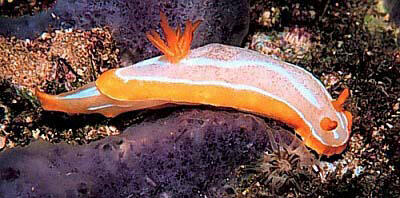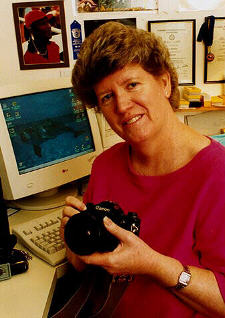 |
Chromodoris buchananae
Photo courtesy of Carol Buchanan
Chromodoris buchananae Gosliner & Behrens 2000
This is the third species described in our first paper of the 'Millennium.' Terry and I named this species in recognition of friend and talented underwater photographer, Carol Buchanan, of New South Wales, Australia. We first met Carol when we were working on Coral Reef Animals of the Indo-Pacific. Her contributions can be seen on many pages, showing Carol's careful eye, and the ability to capture even the smallest subjects. Carol is also responsible for collecting the first and only specimen of these chromodorid species.
The specimen shown above is in fact the 'Holotype' for the species and measured 48 mm in length. We first saw this specimen when it was introduced as Chromodoris sp. 4, on Bill Rudman's Sea Slug Forum. The body is a translucent cream color with small brown flecks. Its has a wide orange marginal band, inside of which is a thin opaque white line. If you look carefully you can see the large acid secreting mantle glands within the tissue of this orange band. The species also has two white lines down the dorsum, which begin in front of the rhinophores and merge just behind the gills. The rhinophores and gills are bright orange.
Chromodoris buchananae was collected at South Solitary Island, in Coff's Harbour, NSW, at a depth of about 45 feet, in February 1997. Coff's Harbour is an interesting coastal environment receiving a mix of temperate and tropical species together. Carol has shared photos showing large brown temperate kelp species growing next to tropical Pocillopora, hard coral colonies. The fish and crustacean species mix similarly.
As this is the only known specimen of Chromodoris buchananae, we hope that
all of you diving the waters of New South Wales will keep you eyes open for
this beauty, and report your finding to us.
Danville, Calif
Nov. 2000
Gosliner, Terrence M. and David W. Behrens. 2000. Two new species of Chromodorididae (Mollusca: Nudibranchia) from the tropical Indo-Pacific, with a redescription of Hypselodoris dollfusi (Pruvot-Fol, 1933). Proc. California Academy of Sciences. Vol. 52 (10): 111-124, 7 figs.
Carol Buchanan
 |
I started diving in 1979, in Sydney, Australia. Because the water was often murky, I started looking at small critters and soon fell in love with nudibranchs. Within a few months, I'd bought my first Nikonos and spent most dives photographing them. In 1982, I moved north, to Coffs Harbour, gateway to the Solitary Islands. The Solitaries are a very special place, a meeting point of temperate and tropical waters. One of the most amazing sights is kelp forests living along side corals. The area is now a Marine Park with many areas being given a large degree of protection with only SCUBA diving being allowed. Moorings are provided to avoid damage to the substrate. Since my first dive in the area, I have been photographing and recording the occurrence of Opisthobranchs within the Solitary Islands. In 1989 I compiled a reference list of Opisthobranch Molluscs from the Solitary Islands and adjacent Coastline. This list included over 200 species, many of which remain undescribed. That the specimen of Chromodoris buchananae was collected within a few metres of a mooring line, in a very heavily dived area, is encouraging. I am fortunate to have the support and encouragement of the members of the Solitary Islands Underwater Research Group, staff of the Solitary Islands Marine Park and NSW Fisheries, who issue the necessary scientific collecting permit which allow my work in this area to continue. |
Taxonomic information courtesy of Dave Behrens

David W. Behrens
Author:
Pacific Coast Nudibranchs
Send Dave mail at seachalleng@earthlink.net
|
